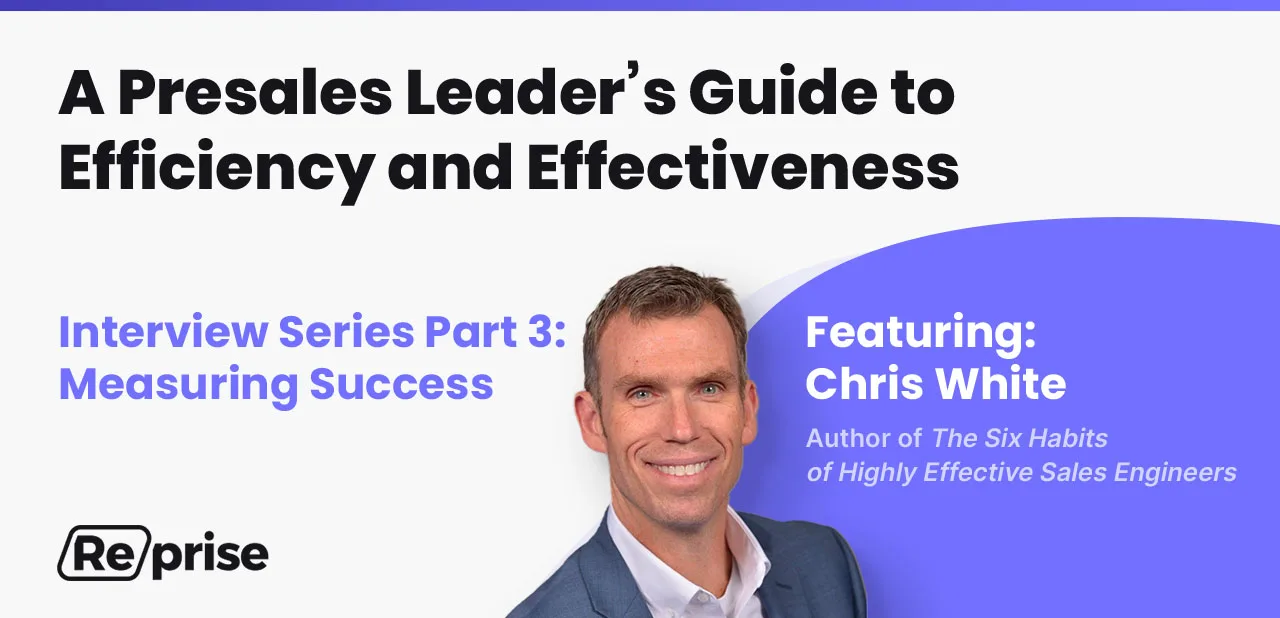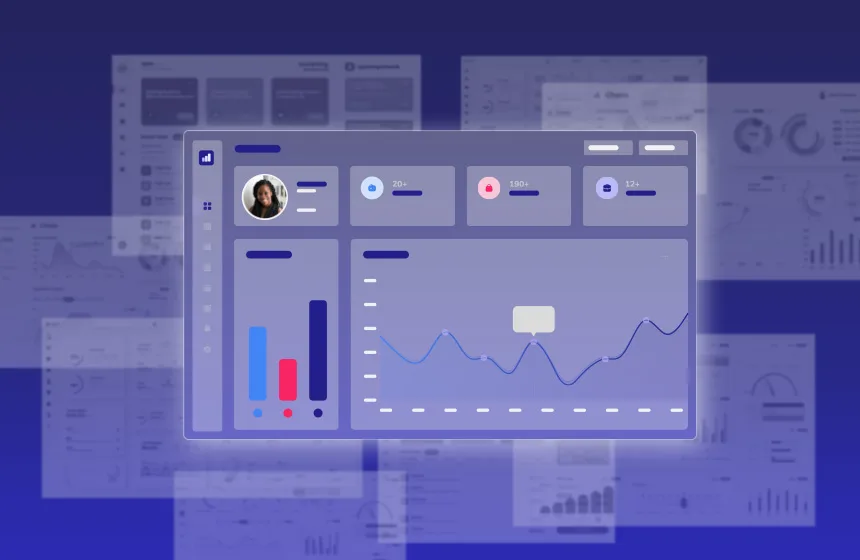A Presales Leader’s Guide Part 3: Measuring Presales Success

March 21, 2024
Table of Contents
Part 3: Measuring success
How do you lead a highly effective presales team, while cutting down on the activities that waste time? That’s the focus of this interview series with Chris White, the founder of TechSalesAdvisors and author of The Six Habits of Highly Effective Sales Engineers. With a more than 30-year career in technical sales and consulting, he’s worked with thousands of sales engineers (SEs), and built a successful framework for delivering winning sales demos.
In our second post, we talked about building a strategy and proactively planning to avoid the all-too-typical fire fighting mentality. The third and final post in our series covers how to measure success, and incorporate coaching and course-correction as needed.
Reprise: What are some common characteristics of highly effective presales teams? What does success look like?
Chris: One is a high level of trust. When someone is assigned to an engagement or an opportunity, they don’t question it, they don’t push back, and they are eager to jump in. A lot of time and effort is wasted in second-guessing strategy and processes, so a high level of trust between the SE leader and SE is needed — as well as between the SE and AE.
Two, they have effective communication. What does that look like? There is a structure for people to elevate issues and concerns. There is a culture of providing necessary feedback. People are not afraid to have difficult conversations.
Reprise: What are some characteristics of these teams’ leadership styles and approaches?
Chris: These leaders prioritize the team, the customer, and the company over themselves. Leaders that are driven by their own personal reasons aren’t as effective. Similar to the ability to have difficult conversations, highly effective leaders can make difficult or unpopular decisions in the interest of a company or customer.
They also prioritize coaching and feedback, and they balance being data-driven with building relationships. Some leaders are purely data-driven — it’s all about the numbers and metrics, or what they can see in a spreadsheet. Others err too far on the side of being relationship-based. These leaders go with their gut and follow their heart so to speak, without managing by data. The most effective and efficient leaders do both.
Reprise: As a presales leader, if you take a step back a quarter or six months from now, how do you measure success? What KPIs do you use?
Chris: This is often a big challenge for SE leaders; for sales leaders it is much easier. However, one of the most important metrics for both sales and SE leaders is: Are we hitting quota or not? Other important factors include: Where and how are we spending our time? Do we have an appropriate balance between customer-facing vs. non-customer-facing activities?
Consider metrics such as attach rates: Of the opportunities in the pipeline, how many of them involve SEs? Of those that involve SEs, what is the close rate of those opportunities? Look at discovery: What percentage of discovery activities are SEs involved in, and what are the close rates of those opportunities? You can also track average deal size: What is the average deal size of those that involve SEs vs. those that do not?
Above all else, SE leaders should ensure that the metrics they’re tracking are meaningful. Are they equipping their team members to provide the data necessary to produce a meaningful metric? Are there potential metrics that are driving inefficiency? For example, if leadership is tracking the number of demos an SE does on a monthly basis, is it possible SEs are just signing up for demos (whether they are qualified or not) to hit a personal quota? Your metrics should align with what is best for the business.
Reprise: What intangible people successes and/or issues do you look for?
Chris: How popular a given SE is with the sales team is certainly one intangible. What kind of feedback are they getting from sales? Are they receiving complaints or accolades? Are they consistently sought out by account executives—even those on different teams, or are they struggling to keep their calendar full?
Another intangible is the desire to improve. Do the individuals on the team consistently demonstrate a desire to change? Or are they set in their ways and show resistance to coaching and new ideas?
As a certified instructor with ASLAN Sales Training, I teach my clients a “Quad Coaching Chart” [see image below], in which I invite sales and SE leaders to rate the members of their team on two dimensions: Results (above the line or below the line) and Desire to Improve (low or high).
- Independents are those who achieve the results but demonstrate a lack of desire to improve.
- Achievers are those who achieve the results AND demonstrate a strong desire to improve consistently.
- Strivers are those who are not yet achieving the desired results BUT do demonstrate a strong desire to improve.
- Detractors are those who are not achieving the desired results AND also demonstrate a lack of desire to improve.
It’s important to note: Desire to improve is based on activity, not attitude. For example, some people have the right attitude and say all the right things, but when you give them an assignment to improve in a specific area, nothing happens. That’s not desire. That’s lip service.
Here’s the problem. As managers, we tend to focus on results, and then channel our coaching energy on those who aren’t achieving the desired results. What happens? Detractors continue to underachieve because they lack desire to improve. And Achievers feel ignored and leave. (Have you ever wondered why good people who are hitting their numbers leave for “better jobs”?)
Want to improve both your efficiency AND effectiveness with your coaching? Shift your focus towards developing those individuals on the right side of the chart—those that demonstrate the desire to improve, regardless of results.
Reprise: If your team is still pulled in too many different directions, how do you course-correct?
Chris: It all begins with making sure SEs understand that they are responsible for how they use their time. Every SE has total responsibility for choosing how they use their time and how they prioritize. If they don’t feel empowered to do so, as a leader, I need to address that.
Some may say, “I have AEs pulling me in too many different directions.” They don’t feel like they can say no. These team members need to feel empowered to push back if an AE is not pulling them into a qualified deal, or if they’re getting involved too early in the process. SEs need to tell leadership how much time they need in certain circumstances to do their jobs.
If there are too many opportunities hitting their radar, maybe there is an imbalance in the AE to SE ratio. As a leader, I need to consider if I have a team structure problem. In that scenario, I can take a step back to look at how many deals my SEs are engaged in on a monthly or quarterly basis. How much time is needed to provide the necessary support?
Do we have enough hours available? From there, I can make a business case for headcount from sales to support the team.
Reprise: How can presales leaders better coach their teams to demonstrate value?
Chris: Make sure your team understands the value proposition and the unique benefits of the solution vs. the competition vs. the status quo. Are they equipped with the right knowledge and information in order to lead with value and sell with a value mindset?
Equip them with demo templates, scripts, scenarios, demo flows, and collateral that emphasizes the value, outcomes, and benefits — over the technical details and the how-to. SEs need to invest the time to either review demo calls, sit in on demos, and/or do mock demo training and role playing. Leaders then need to provide feedback through one-to-one coaching.
Here’s the unfortunate truth about coaching: There are no shortcuts. I can be highly effective in coaching, but if I do so at the expense of my other responsibilities, I’m effective but not particularly efficient. Most leaders are too efficient in coaching. They provide quick, flash-in-the pan feedback without taking the time to first understand and evaluate the performance of their team members.
Regardless of the coaching model you follow (there are a number of best practices in the market) leaders need to be trained on how to coach. If they aren’t, their people suffer. While SEs may be getting feedback, it doesn’t mean they are getting effectively coached. One common mistake is giving SEs 10 things they should do differently. Nobody can correct 10 things at once. Instead, managers need to hone in on one skill or technique, and help them focus until they develop competency. Then, move on to another area for improvement.
***
That concludes our interview series with Chris White. Want even more presales leadership tips?
Check out our on-demand webinar with Chris White:







